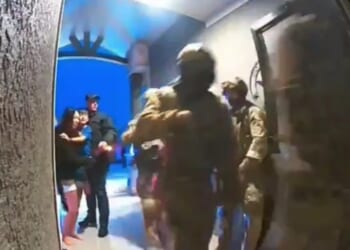Despite prior cancellation, the Navy seeks renewed funding for submarine-launched nuclear missiles to enhance deterrence and second-strike capability amid rising Indo-Pacific tensions and long-term strategic competition with China.
U.S. lawmakers have been debating the capabilities and merits of a proposed “nuclear-armed sea-launched cruise missile (SLCM-N),” a weapon that was initially proposed during the first Trump Administration in 2018.
Following the 2022 Nuclear Posture Review (NPR), the periodic assessment of the country’s nuclear policy, then-President Joe Biden canceled the program.
A United States Navy official told lawmakers that the SLCM-N would be one of the service’s top three warfighting priorities. The missile could be launched from the service’s Virginia-class fast attack submarines (SSNs).
Vice Adm. Johnny Wolf, director of the U.S. Navy’s Strategic Systems Programs, told the House Armed Services Committee’s strategic forces subcommittee that issues still need to be considered.
“Executing this program requires careful balancing of resources,” Wolfe explained, per USNI News, adding that SLCM-N had previously provided the president with second-strike capabilities.
“Over the last year, the SLCM-N program has focused on understanding and determining the weapon system’s architectures,” Wolfe added in his prepared remarks to the lawmakers.
“SLCM-N development will span the missile 10 system, fire control, launcher system, platform integration, and warhead system integration, as well as development of applicable support equipment, telemetry, flight test hardware, ashore infrastructure, and training material. The program office has focused on defining the system architecture that integrates these elements.”
The U.S. Navy is already working with the United States Strategic Command (USSATCOM) and the Indo-Pacific Command (PACOM) to finalize the concept of operations and ensure it can be employed with the Virginia-class boats.
Lawmakers have already been convinced that the SLCM-N requires investment, with $2 billion for mission development and an additional $400 million for the nuclear warhead included in the current $150 billion defense bill proposal.
The Return of the SLCM-N to the U.S. Navy
If this program moves forward, it would be the first SLCM-N deployed on the U.S. Navy’s nuclear-powered submarines since just after the end of the Cold War.
“The U.S. Navy first deployed a nuclear-armed sea-launched cruise missile in the mid-1980s, when it placed the TLAM-N, a nuclear-armed version of the Tomahawk land-attack cruise missile, on surface ships and attack submarines. With a range of 2,500 kilometers, the missiles were not included in the limits in U.S.-Soviet arms control agreements,” Congress.gov explained.
However, in 1991, then-President George H.W. Bush ordered the withdrawal of land-based tactical nuclear weapons from overseas bases, while he also ordered all sea-based tactical nuclear weapons to be removed from surface ships, submarines, and naval aircraft.
The Obama administration went even further and formally retired the system in 2013.
The first Trump administration had sought to reverse the decision and provide the U.S. with a “non-strategic regional presence.” The White House seems even more determined to see the missiles returned to service.
The SLCM-N would feature an “All Up Round” configuration, consisting of a booster, cruise missile, and launch canister. According to Interesting Engineering, it would be “compatible with Virginia Payload Tubes (VPT) and Virginia Payload Modules (VPM).”
The VPT and VPM will be installed on the Virginia-class Block V boats that are now being constructed. They were designed to maintain undersea dominance amid rising threats from China in the Indo-Pacific.
About the Author: Peter Suciu
Peter Suciu has contributed over 3,200 published pieces to more than four dozen magazines and websites over a thirty-year career in journalism. He regularly writes about military hardware, firearms history, cybersecurity, politics, and international affairs. Peter is also a Contributing Writer for Forbes and Clearance Jobs. He is based in Michigan. You can follow him on Twitter: @PeterSuciu. You can email the author: [email protected].
Image Credit: Shutterstock/ U.S. Department of Defense.
















